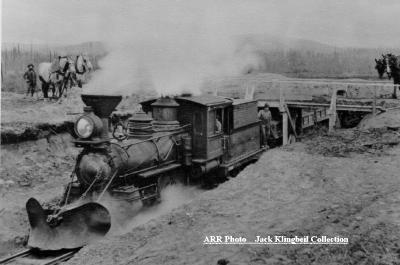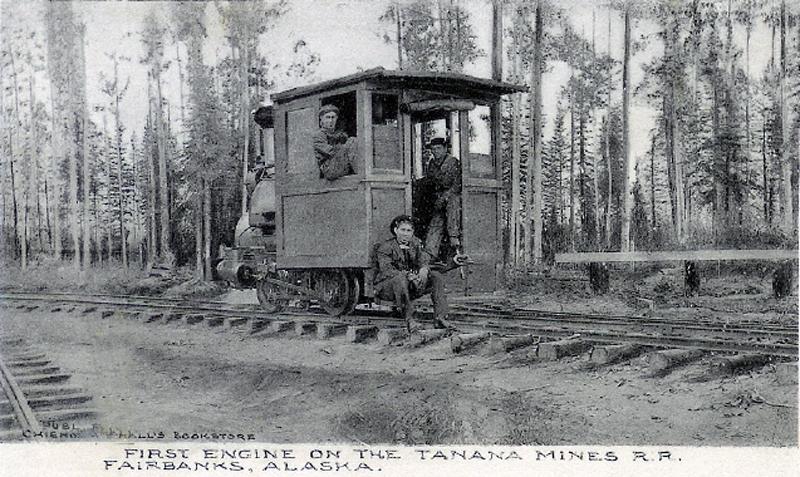Tanana Valley Railroad
Written by the Friends
of the Tanana Valley Railroad, Inc.
The Tanana Valley Railroad (TVRR) began life as the Tanana
Mines Railway. Falcon Joslin and Martin Harrais, entrepreneurs living
in Dawson, Yukon Territory, Canada, learned of the gold strikes in the
Chena and Chatanika river basins. Residents of the area needed a dependable,
year-around means of transportation to move people and supplies to and
from the mines. In 1903, Joslin and Harrais traveled to the Tanana Valley
to evaluate the possibility of building a railroad from the Tanana River
to Fairbanks and the gold fields. Returning to Dawson, they laid plans
and secured financial backing from British investors who had financed several
small industrial railroads in the Dawson area and the White Pass And Yukon
Route.
 Initial
construction began in late summer of 1904 at Chena with the erection of
a sawmill, rail yard and other support structures. Roadbed preparation
and track laying commenced, but soon came to a halt due to unforeseen engineering
problems. Ground that looked deceptively smooth and even, perfect for laying
track, turned into a quagmire of swamps and small streams due to the hidden
permafrost that thawed as soon as the ground cover was disturbed. When
it refroze in winter, it was hard as rock, and tools designed for dirt
and gravel wouldn't budge in the frozen ground.
Initial
construction began in late summer of 1904 at Chena with the erection of
a sawmill, rail yard and other support structures. Roadbed preparation
and track laying commenced, but soon came to a halt due to unforeseen engineering
problems. Ground that looked deceptively smooth and even, perfect for laying
track, turned into a quagmire of swamps and small streams due to the hidden
permafrost that thawed as soon as the ground cover was disturbed. When
it refroze in winter, it was hard as rock, and tools designed for dirt
and gravel wouldn't budge in the frozen ground.
Coupled with these unexpected engineering difficulties,
the lack of special equipment and supplies needed for construction made
progress proceed in spurts, dependent on the arrival of riverboats that
were dependent on the ice breakup of the Yukon and Tanana Rivers! The initial
shipment of supplies that came during the summer of 1904 quickly ran out,
and was not replenished until mid-May of 1905. That year, Spring brought
a flurry of activity with the arrival of countless ship loads of supplies
and equipment for the railroad, and construction activity commenced with
a renewed fervor. But, until the arrival of Engine #1 on July 4, men and
animals provided the "horsepower" for roadbed construction!
Engine #1, which had been the first steam locomotive in
the Yukon Territory, now became the first steam locomotive in the interior
of Alaska. It went right to work building the railroad. The mainline was
completed to Fairbanks by mid-July and the golden spike, minted from gold
from the surrounding area, was driven on July 17. Construction continued
on the branch up the Goldstream valley through Fox.
That branch was completed to Gilmore in September.
In 1907, the railroad was refinanced under a new name,
the Tanana Valley Railroad and on May 15, 1907, construction began on the
second phase of the TVRR, an extension of the trackage to Chatanika. The
route was originally planned to go over Cleary Summit, but new mining
activity in the Dome, Vault, Ridgetop and Olnes areas caused the railroad
to be routed up the Fox Creek Valley to meet the needs of the new communities.
On September 29, the construction crew reached Chatanika after building
an additional 19.2 miles of railroad in four months, including over a mile
of trestles and bridges!
Freight, passenger service and revenue continued to grow
through 1909. At one time the railroad operated 3 mixed trains daily each
way, in addition to special schedules. Using the railroad, instead of horse
or mule-drawn wagons, the citizens of the area were able to save over $300,000
a year in freight costs. Occasionally, severe winter storms would bring
operations to a halt, but the trains were usually back in operation within
a couple of days.
Beginning in 1910, due primarily to the appearance of
a new means of transportation, revenues began to drop. The railroad never
recovered and finally, on November 1, 1917, the TVRR was sold at a bankruptcy
sale for $200,000. The buyer resold the TVRR to the Alaska Engineering
Commission (AEC) for $300,000 on December 31, 1917. The TVRR became the
Chatanika Branch of the Alaska Engineering Commission Railroad, which became
the Alaska Railroad in 1923. All of the equipment was renamed to reflect
the new ownership and the Tanana Valley Railroad became a memory of days
gone by.
Operations continued, and the AECRR built an extension
to Nenana to meet the track coming north from Anchorage. This new section
was finally completed, with crews building north from Nenana and south
from Fairbanks, on November 7, 1919, and then was widened to standard gauge
as soon as the Mears bridge over the Tanana River at Nenana was completed
(February 1923). By May 8, the standard-gauge trackage had reached Happy,
where the original TVRR route branched off to go up Goldstream Valley.
From Happy to Fairbanks the railroad laid an additional
rail parallel to the narrow-gauge track to create dual-gauge, allowing
both the narrow-gauge and the new standard-gauge equipment to use the same
roadbed. The standard-gauge addition reached the northern terminus in Fairbanks,
during the first week of June. Through traffic from Fairbanks to tidewater
at Seward began immediately, even though the "official" completion of the
railroad, with the golden spike ceremony, didn't occur until almost a month
later, on July 15.
Narrow-gauge operations continued on the Chatanika Branch
of the Alaska Railroad, the old TVRR, and for awhile the railroad was able
to make ends meet financially. However, continued competition with motor
vehicles on the developing road system took its toll. Finally, facing continual
losses on the Chatanika Branch, the ARR decided to close down the line
and on August 1, 1930, the last scheduled train returned to Fairbanks.
The ARR officials tried to salvage as much of the equipment as
they could and some of the cars were relocated to mining operations in the Matanuska
Valley or re-sized to operate on the standard gauge, but the rest was sold for
surplus. The track was removed in 1931 and the buildings were scrapped or salvaged
for use in other structures. If you look carefully, you can find part of the
train station in a house in Aurora subdivision in Fairbanks! The remains of
trestles and bridges, and occasional spikes and ties, can still be found along
the old right-of-way. Engine #1, the very first engine purchased for the TVRR,
was placed on display in Fairbanks and eventually ended up at Alaskaland. Due
to the efforts of local citizens, it has been restored and returned to operation
at Alaskaland, the local community park. Engine No.152, the last engine purchased
for the railroad, operates in Crossroads Village, a community park near Flint,
Michigan.
See also:

 Initial
construction began in late summer of 1904 at Chena with the erection of
a sawmill, rail yard and other support structures. Roadbed preparation
and track laying commenced, but soon came to a halt due to unforeseen engineering
problems. Ground that looked deceptively smooth and even, perfect for laying
track, turned into a quagmire of swamps and small streams due to the hidden
permafrost that thawed as soon as the ground cover was disturbed. When
it refroze in winter, it was hard as rock, and tools designed for dirt
and gravel wouldn't budge in the frozen ground.
Initial
construction began in late summer of 1904 at Chena with the erection of
a sawmill, rail yard and other support structures. Roadbed preparation
and track laying commenced, but soon came to a halt due to unforeseen engineering
problems. Ground that looked deceptively smooth and even, perfect for laying
track, turned into a quagmire of swamps and small streams due to the hidden
permafrost that thawed as soon as the ground cover was disturbed. When
it refroze in winter, it was hard as rock, and tools designed for dirt
and gravel wouldn't budge in the frozen ground.
